|
| |
- This page contains information and pictures about Weevils that we found in
the Brisbane area, Queensland, Australia.
-
 -
- The beetles in this family are commonly called Weevil or True Weevil. The adults characterized by
the elongated rostrum, the front part of their head and mouth, which they use to chew holes in plants for food and to make egg chambers.
Their antennae usually elbowed and
clubbed. They usually have
rigid bodies. They are from small to very large size. Most of them are less than 10mm, although the largest can be up to 60mm.
-
-
When disturbed, weevils usually drop onto the ground and play
death. After a minutes without further disturb, it will slowly walk away.
-
- Both
adults and larvae are plant feeders. Adults usually found on leaves.
Larvae can be found in soil near roots, rotting wood or in stem.
Classification :
- The classification of Curculionidae is very confusing. We sometimes found
classification problems and our rule is - follow the Australian Faunal Directory.
This is not working in Curculionidae for it is still blank under Curculionidae
in Australian Faunal Directory. We largely follow Zimmerman here in the Curculionidae
classification.
-
- The weevils we found in this family Curculionidae are grouped as follows;
-
-
- Some References put this group as subfamily Brachycerinae.
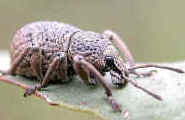 Adelognatha, Subfamily Entiminae - Broad-nosed Weevils Adelognatha, Subfamily Entiminae - Broad-nosed Weevils- Adults of this subfamily are characterized by having a relatively short
and stout rostrum, boarder at the tip. They are from moderate to large size.
The larvae usually live in soil and feed on root.
-
-
-
-
-
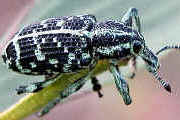 Subfamily Aterpinae Subfamily Aterpinae- Weevils in this subfamily are medium size. They usually have the parallel
cylindrical body. Their rostrum is medium length.
-
-
-
-
-
-
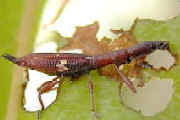 Subfamily Aterpinae, Rhadinosomini Subfamily Aterpinae, Rhadinosomini- We only found on species in this group. The weevil has extremely elongated
body. It is brown in colour with a creamy-white pattern on each side of
wings cover.
-
-
-
-
-
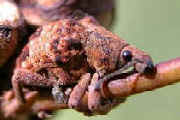 Subfamily Gonipterinae
- Eucalyptus Weevils Subfamily Gonipterinae
- Eucalyptus Weevils- We found a few species in this subfamily all are in genus Gonipterus.
They are commonly know as Gum Nut Weevils. Those weevils usually sit
next to gum nuts and camouflaged as one of them. The larvae of this subfamily are
usually slug-like and external foliage-feeding.
-
-
-
-
-
- Some References put this group as subfamily Curculioninae.
-
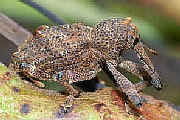 Subfamily
Molytinae - This is a large subfamily. Members are usually have relatively long legs
and long rostrum. Subfamily
Molytinae - This is a large subfamily. Members are usually have relatively long legs
and long rostrum.-
-
-
-
-
-
-
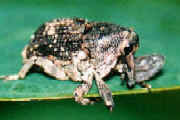 Subfamily Cryptorhynchinae
- Long-legged Weevils Subfamily Cryptorhynchinae
- Long-legged Weevils
- This is a large subfamily. Members are usually have relatively long legs
and with a long backwardly directed rostrum.
-
-
-
-
-
-
 Subfamily
Curculioninae Subfamily
Curculioninae
- Weevils in this group are from small to large in size. They have long and cylindrical
rostrum with round eyes.
-
-
-
-
-
-
- Reference:
- 1. Insects
of Australia, CSIRO, Division of Entomology, Melbourne University
Press, 2nd Edition 1991, p 682.
- 2. Insects of Australia and New Zealand - R. J. Tillyard, Angus
& Robertson, Ltd, Sydney, 1926, p241.
- 3. Beetles
of Australia - Trevor J Hawkeswood, Angus & Robertson Publishers,
1987, p173.
- 4.
Northern
Territory Insects, A Comprehensive Guide CD - Graham Brown, 2009.
- 5. A
Guide to the Beetles of Australia - George Hangay and Paul Zborowski,
CSIRO PUBLISHING April 2010, p215.
- 6. Curculionidae Latreille, 1802
- Australian National Insect Collection Database - CSIRO, 2011.
- 7. Family CURCULIONIDAE - Australian Faunal Directory, Australian Biological Resources Study.
- 8. Australian
Weevils - Zimmerman, E.C., CSIRO PUBLISHING, 1991, Plate 425.
-
[ Up ] [ BELIDAE ] [ ATTELABIDAE ] [ BRENTIDAE ] [ CURCULIONIDAE ] [ Unknown Weevils ]
| |
|

 Adelognatha, Subfamily Entiminae - Broad-nosed Weevils
Adelognatha, Subfamily Entiminae - Broad-nosed Weevils Subfamily Aterpinae
Subfamily Aterpinae Subfamily Aterpinae, Rhadinosomini
Subfamily Aterpinae, Rhadinosomini Subfamily Gonipterinae
- Eucalyptus Weevils
Subfamily Gonipterinae
- Eucalyptus Weevils Subfamily
Molytinae - This is a large subfamily. Members are usually have relatively long legs
and long rostrum.
Subfamily
Molytinae - This is a large subfamily. Members are usually have relatively long legs
and long rostrum. Subfamily Cryptorhynchinae
- Long-legged Weevils
Subfamily Cryptorhynchinae
- Long-legged Weevils Subfamily
Curculioninae
Subfamily
Curculioninae
